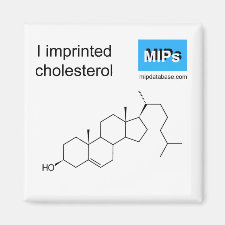
Authors: Li XL, Tong YJ, Jia L, Guan HM
Article Title: Fabrication of molecularly cholesterol-imprinted polymer particles based on chitin and their adsorption ability.
Publication date: 2015
Journal: Monatshefte für Chemie - Chemical Monthly
Volume: 146
Issue: (3)
Page numbers: 423-430.
DOI: 10.1007/s00706-014-1369-4
Abstract: Molecularly imprinted polymers (MIPs) are new materials for molecular identification ability with specific identification, preordainment, and wide applicability. A cholesteryl chitin carbonate (Chol-Chi) was synthesized via two steps, and its chemical structure was characterized by Fourier transform infrared spectroscopy and solid-state 13C nuclear magnetic resonance. The resulting Chol-Chi was used as a covalently bound template precursor for imprinting cholesterol. After this precursor was cross-linked with toluene-2,4-diisocyanate, the carbonate bond in the cross-linked Chol-Chi obtained was cleaved hydrolytically to afford a guest-binding site accompanying the easy and efficient removal of a sacrificial spacer. Field emission scanning electron micrograph observation showed that the surface on MIP particles was rough and porous. The equilibrium adsorption capacity for the molecularly cholesterol-imprinted polymer (Chol-MIP) was 13.60 mg/g, while that of the cholesterol-non-imprinted polymer (Chol-NIP) was only 4.75 mg/g when concentrations of the MIP and NIP equaled to 20.0 mg, respectively. Reusability of Chol-MIP with negligible loss of the initial adsorption capacity was observed after five adsorption-desorption cycles. In addition, stigmasterol and estradiol were selected as competitive molecules in selectivity tests, and the MIPs showed a good specific selectivity and intense recognition of cholesterol
Template and target information: cholesterol, Chol
Author keywords: Cholesteryl chitin carbonate, Equilibrium adsorption, molecularly imprinted polymer, sacrificial spacer, selectivity



Join the Society for Molecular Imprinting

New items RSS feed
Sign-up for e-mail updates:
Choose between receiving an occasional newsletter or more frequent e-mail alerts.
Click here to go to the sign-up page.
Is your name elemental or peptidic? Enter your name and find out by clicking either of the buttons below!
Other products you may like:
 MIPdatabase
MIPdatabase









